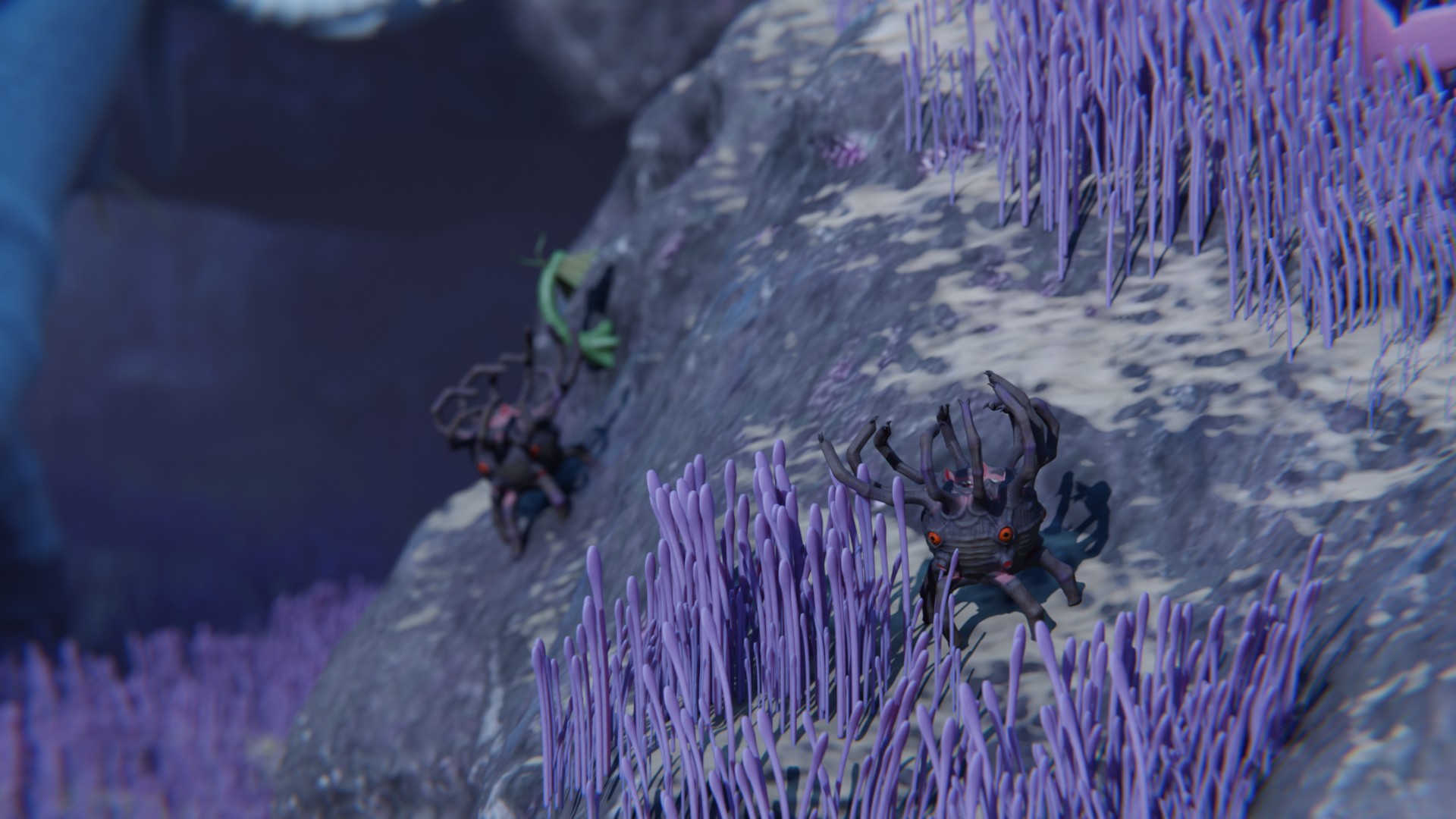Barreldactyl
Barreldactyls have given up their ancestral filterfeeding for a life of ambush predation, and with it they have become smarter, better coordinated, and better at seeing coming prey. Pictured here, in the foreground a barreldactyl descends a rockface looking for more prety, while in the background another attempts to attack an umtrabella. [Creature design by Dapper Dino]
Basic Information
Anatomy
Starting to target larger and larger prey has led to strong selection pressure in barreldactyls. As a result they have developed a cartilaginous skeleton with numerous joints. At the aboral end are five legs with three joints each. Each leg segment is supported by a rod of stiff cartilage. Above this is hip like structure called the kalathischium, which supports the weight of the internal organism and also provides muscle attachment sites for the proximal segment of the legs. Above the kalathischium and surrounding the nerve bundles that run from each of the five brain ganglia to the eyes, reparatory orifices, legs, and arms, are cartilaginous tubes called paranotochords which protect the nerves as well as providing additional support to the respiroreproductive tract, the eyes, and the upper limbs. Each eye now contains a muscular sphincter which allows it to focus and adapt to differing light levels. The respiroreproductive organs are generally very similar to those of the ancestral feather barrel, although muscle attachemtns to the paranotorchords allow them to be more finely and strongly controlled, so like the sea tumbleweed a barrel dactyl can make surprisingly fast getaways using the tubes midway down its body as quick water jets. Lining the oral end of the creature are 10 feeding arms, each with 4 segments supported by stiff cartillage, and bearing 2 chitinous claws at their distal end. These limbs are supported by a series of 5 radial skeletal elements called ossa pectorum circularia (singular os pectus circulare). Each sits directly above an eye, and supports two arms with muscle attachment points. Within the oral end of the central digestive cavity are several hard calcified teeth, and the whole area is lined by 3 separate sphincters which can constrict the oral orifice to help process food. The sphincters are arranged one on top of each other along the oral-aboral axis. Like the ancestral featherbarrels and sea tumbleweed, barreldactyls have essentially 5 brains, each consisting of a cluster of ganglia that sit medial to the eyes, and which extend nerve clusters orally, aborally, and around the circumference of the organism to connect to the other ganglia clusters.
Genetics and Reproduction
Barreldactyls are one of the few species that have trended toward K selection on Almaishah. Around the northern vernal equinox, males will begin to seek out mates. If two or more encounter the same female they will push each other around while threateningly waving their feeding arms. These shoving matches rarely result in injury, but the stronger bigger male will generally force a retreat in any other males, and then he and the female will mate. The female will remove 5 large eggs, each from one respiratory outlet orifice, which will then be fertilized by the male by expelling milt over them. The eggs are sticky and are pushed into a crevasse in a rock, after an hour or so, they will exude a cement similar to that used by the ancestral feather barrel to adhere its "roots" to the substrate. These eggs are guarded by both parents, who will take turns going out to hunt and guarding the eggs.
Growth Rate & Stages
When the eggs hatch, juveniles emerge at about 5 cm tall (excluding the feeding arms). They are miniature versions of the adult form, but with pink skin. When young they will feed on small organisms they can catch as well as regurgitated food from both parents. While bellow 15 cm in height (excluding the feeding arms) they are quite agile in the water swimming with jets from their respiroreproductive tract. As the juveniles age their skin darkens, and when they reach 20cm in height (excluding the feeding arms) they are expelled from the family group.
Ecology and Habitats
Barreldactyls live in the Yama-Natash major reefs system, as well as in rocky intertidal regions around Yama and Kubshay.
Dietary Needs and Habits
Barreldactyls are ambush predators who hide in rock crevices and in stands of seagrasso. They take prey up to 10 cm long by stabbing it with their feeding claws, dragging it to their mouths, and then further shredding their prey with their teeth. Barreldactyls typically make most of their diet up in nektonic xenosegmentans, and slow moving phytozoans.
Additional Information
Average Intelligence
Similar to a goldfish
Perception and Sensory Capabilities
With the new found ability to focus and change the amount of light entering the eyes, the barreldactyl has extremely keen vision. Further enhancements in the communication between ganglia has given the barreldactyl 360° binocular vision. This is vital as the eyes cannot see directly above the organism, but this is where it feeds, so it must keep track of the speed, direction, and distance of targets so that it can predict when they are in range of its clawed feeding arms. This has also come with a significant advancement in neural processing power, and barreldactyls are some of the smartest creatures to have evolved by this time, although by modern earth standards they are still rather dumb, being not much smarter than a gold fish.
EXTINCT
Genetic Ancestor(s)
Scientific Name
Arthrodactyl lithoraptor
Origin/Ancestry
Xenoradiata
Lifespan
5 local years
Average Height
30 cm (excluding feeding arms)
Body Tint, Colouring and Marking
Barreldactyls have dark colored skin over most of their body, that helps them blend in with the rocks they live on and among. They also often have irregular purple patches on their skin that resembles the color of a patch of retinalphyte growth, to further camouflage them.
Geographic Distribution
Remove these ads. Join the Worldbuilders Guild











Comments